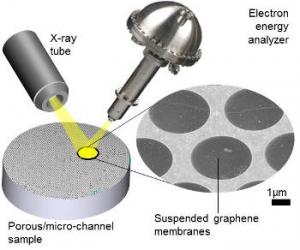Researchers from the National Institute of Standards and Technology (NIST), ELETTRA (Italy) and Technical University of Munich (Germany) have found that graphene could make using XPS (X-ray photoelectron spectroscopy) much less expensive and complicated.

XPS is a sensitive and informative surface analysis technique, that is often deemed unfit since it is expensive and requires a high vacuum to operate - making analyzing liquid and gas materials problematic. XPS works by bombarding the surface under study with X rays. The atoms on the surface of the material absorb the X-ray energy and re-emit that energy as photoelectrons. Scientists study the kinetic energy and number of the emitted electrons for clues about the sample’s composition and electronic state.
To solve the problem of working with pressurized environments, a window material is needed that is nearly transparent to X rays and photoelectrons, but impermeable to gases and liquids and strong enough to endure great pressure. The scientists turned to graphene and explored it as a window material to separate their sample stage’s atmospheric pressure liquid compartment from the high-vacuum conditions inside the electron spectrometer.
The results showed that enough x-rays and photoelectrons managed to pass through the graphene window to produce good quality XPS data from liquids and gases. The researchers are confident that this discovery can benefit many scientists that could enjoy desirable capabilities in a potentially low cost due to a simple design.
Some challenges remain, like the adhesion of the graphene to the surface surrounding the opening which needs to be improved, as well as the barrage of X rays that degrades atomically thin graphene over time.